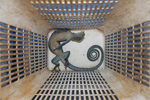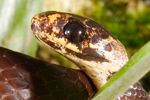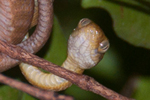
A live Imantodes chocoensis. Its head is about the size of an American penny. Photo by: Omar Torres-Carvajal et al.
There’s no question that blunt-headed vine snakes are an odd lot: a thin body tapers into an even thinner neck which expands suddenly into a broad head with massive eyes. Until now only six species were recognized from this genus, known as Imantodes, but a new study in Zookeys describes a seventh species: Imantodes chocoensis from the Chocó Forests in northeastern Ecuador.
The new species is distinct due to its lack of a loreal scale—a large scale on its head that all other blunt-headed vine snakes possess. Interestingly, the new species closest relative, the Amazon Basin tree snake (Imantodes lentiferus), is actually a mountain chain away: it’s found on the other side of the Andes in the Amazon rainforest. All blunt-headed vine snakes are night hunters, using their big eyes to track down lizards and frogs.
“One possible explanation for the disjunct distribution between the new species and its closest relative is that the uplift of the Andes fragmented an ancestral population into two, each of which evolved into a different species, one in the Chocó region and the other in the Amazon,” explains lead author Omar Torres-Carvajal from Museo de Zoología QCAZ in a press release. The researchers believe the new species is also found in Colombia.
The Imantodes chocoensis is named after its forest home, translating into the “Chocoan blunt-headed vine snake.” Resting between the Pacific and the Andes, the Chocó Forest of Ecuador and Colombia is home to a stunning richness of biodiversity and many species found-no-where-else, but is under increasingly threat due to deforestation. In Ecuador over 90 percent of the Chocó ecosystem has already been lost. The researchers did not remark on whether they think the Chocoan blunt-headed vine snake is endangered.

Close up of Imantodes chocoensis. Its head is about the size of an American penny. Photo by: Omar Torres-Carvajal et al.
CITATION: Torres-Carvajal O, Yánez-Muñoz MH, Quirola D, Smith EN, Almendáriz A (2012) A new species of blunt-headed vine snake (Colubridae, Imantodes) from the Chocó region of Ecuador. ZooKeys 244: 91. doi: 10.3897/zookeys.244.3950
Related articles
Indonesia remains epicenter for illegal wildlife trade in reptiles and amphibians

(10/24/2012) Demand for exotic pets is driving the illegal harvest and trade of herpetofauna (reptiles and amphibians) in Indonesian New Guinea, according to a recent study published in the journal Biodiversity and Conservation. Between September 2010 and April 2011, Daniel Natusch and Jessica Lyons of the University of New South Wales surveyed traders of amphibians and reptiles in the Indonesian provinces of Maluku, West Papua and Papua.
Scientists name new snake species to criticize mine plans in Panama (photos)

(09/18/2012) While scientists increasingly name new species after celebrities in order to gain much-needed attention for the world’s vanishing biodiversity, researchers describing a new snake species from Panama have taken a different route. Dubbing the new serpent, Sibon noalamina (‘no to the mine!’ in Spanish), the scientists are hoping the multicolored snake’s unusual name will draw attention to mining and deforestation issues in Panama’s remote Tabasará mountains.
Arachnopocalypse: with birds away, the spiders play in Guam

(09/17/2012) The island of Guam is drowning in spiders. New research in the open-access journal PLOS ONE has found that in the wet season, Guam’s arachnid population booms to around 40 times higher than adjacent islands. Scientists say this is because Guam, a U.S. territory in the Pacific, has lost its insect-eating forest birds. Guam’s forests were once rich in birdlife until the invasion of non-native brown tree snake (Boiga irregularis) in the 1940s decimated biodiverse bird communities. Now, the island is not only overrun with snakes, but spiders too.